
An open fire door will allow smoke and flames to spread and compromise the means of egress. Closed and latched fire doors will help to compartmentalize the building.
When I first started working in the door and hardware industry, I learned all about the rules that apply to fire doors, but I didn’t fully appreciate the value of a closed door during a fire. Over the years, I have attended several fire tests, and I was amazed that I could stand beside a wood fire door with a raging fire in the furnace only 1 ¾ inches away. This really helped me to understand the protection provided by that door.
Recently, there has been a lot of press covering the benefits of closed doors during a fire – both fire doors and basic residential doors. Fire departments have shared photos and videos on social media, showing rooms that were totally devastated during a fire, beside a room with almost no damage because the door was closed when the fire occurred. In addition to limiting property damage, these protected rooms provided much more time for occupants to become aware of the fire and assess their options for egress.
Much of the increased understanding of the benefits of closed doors was initiated by research done by Underwriters’ Laboratories (UL), and the website that was created to help educate the public. UL shares their message of “Close Before You Doze” on CloseYourDoor.org, which teaches about the fire safety benefits of sleeping with the bedroom door closed. Many news reports included footage of the fire tests behind this safety campaign, which monitored temperature and air quality in the various rooms of the burning home.
In addition to the positive news reports about lives saved by closed doors, there have been tragic examples of what happens when doors are left open during a fire. Fatalities caused by open doors often occur in multi-family residential buildings, where the doors between common corridors and individual dwelling units are usually required to be 20-minute fire door assemblies. In late December of 2017, 13 people were killed in a fire in the Bronx, when the door to the apartment where the fire began was left open when the occupants escaped. The fire spread quickly up the open stairwell, compromising the means of egress and preventing other residents from evacuating.
After that fire occurred, much of the media attention focused on the person who fled the burning apartment and didn’t close the door behind her. But subsequent investigations found that the doors should have been self-closing, self-latching fire doors, which would not have required a panicked mother fleeing with her two toddlers to think about manually closing the door. It’s critical for the general public to understand the purpose of fire doors, and for locksmiths and others in the door and hardware industry to know what to look for when servicing a fire door assembly. We see these non-compliant fire doors every day, but are we doing what we can to ensure that they provide the necessary level of protection?

Fire door labels state the duration of the fire door test – between 20 minutes and 3 hours. A code-compliant fire door assembly is expected to protect the opening for this amount of time.
Fire Door Inspections
NFPA 80 – Standard for Fire Door Assemblies and Other Opening Protectives, includes detailed requirements that pertain to swinging fire doors as well as other types of opening protectives. The
model codes used in most US states reference NFPA 80 for prescriptive requirements for fire door assemblies, including installation and maintenance. Where an adopted building code or fire code requires fire door assemblies to be installed or maintained in accordance with NFPA 80, the standard mandates periodic inspections.
In the 2007 and 2010 editions of NFPA 80, inspections are required annually as part of the maintenance of the fire door assemblies. These annual inspections help to ensure that the components remain functional and the door is closing and latching properly. Beginning with the 2013 edition of NFPA 80, the standard requires inspections to be performed after installation and after maintenance work, as well as annually. Are inspections being conducted after you install or modify a fire door?
Enforcement of the inspection requirements varies by jurisdiction. Thousands of health care facilities receive funding from the Centers for Medicare and Medicaid Services (CMS) and are surveyed by accrediting organizations like the Joint Commission; annual fire door inspections ARE required for these facilities. I have also seen enforcement of the inspections in colleges and universities, and in multifamily residential buildings where fires are not uncommon and building maintenance is not always performed proactively. Hopefully, enforcement will continue to increase until all fire doors are code-compliant and performing as designed and tested. Even if a particular jurisdiction is not enforcing documented inspections, it is still the responsibility of the building owner to keep fire door assemblies in proper working order, and failure to do so can result in liability if a fire occurs.
NFPA 80 requires fire door inspections to be performed by a qualified person, with knowledge and understanding of the components that are being inspected. An inspector may demonstrate their qualifications by possession of a recognized degree, certificate, professional standing, or skill. The Authority Having Jurisdiction (AHJ) may require specific training or documentation over and above the mandates of NFPA 80, but the Joint Commission does not currently require inspector qualifications that are different from those stated in NFPA 80.
Inspection Documentation
Recent editions of NFPA 80 mandate the following information for the inspection report:
- Date of inspection
- Facility name and address
- Inspector name(s), company name, address, and signature
- Individual record of each fire door assembly inspected and tested, with unique opening identifier, location of assembly, and description
- Verification of visual inspection and functional operation
- List of deficiencies in accordance with the inspection criteria
The 13 inspection criteria currently required by NFPA 80 are:
- Labels clearly visible and legible
- No open holes or breaks in the surface of the door or frame
- Glazing, vision light frames, and glazing beads intact and securely fastened
- Door, frame, and all hardware secured, aligned, and in working order
- No missing or broken parts
- Clearance within the limits mandated by NFPA 80
- Closing device is operational and the door closes completely from the fully-open position
- Coordinator (pairs only) operates properly to close the inactive leaf before the active leaf
- Latching hardware operates properly and secures the door in the closed position
- No auxiliary hardware which interferes with proper operation of the assembly
- No field modifications have been performed that void the label
- Perimeter and meeting-stile gasketing are intact (if required)
- Signage attached to the door meets the limitations of NFPA 80 for size and attachment
For locksmiths who are installing or modifying fire doors frequently, the inspection requirements present an opportunity to provide an additional service to existing customers as well as a way to connect with new facilities. Several training programs are available to help ensure an acceptable level of understanding of the code requirements that apply to fire door assemblies.
Code-Compliance Matters
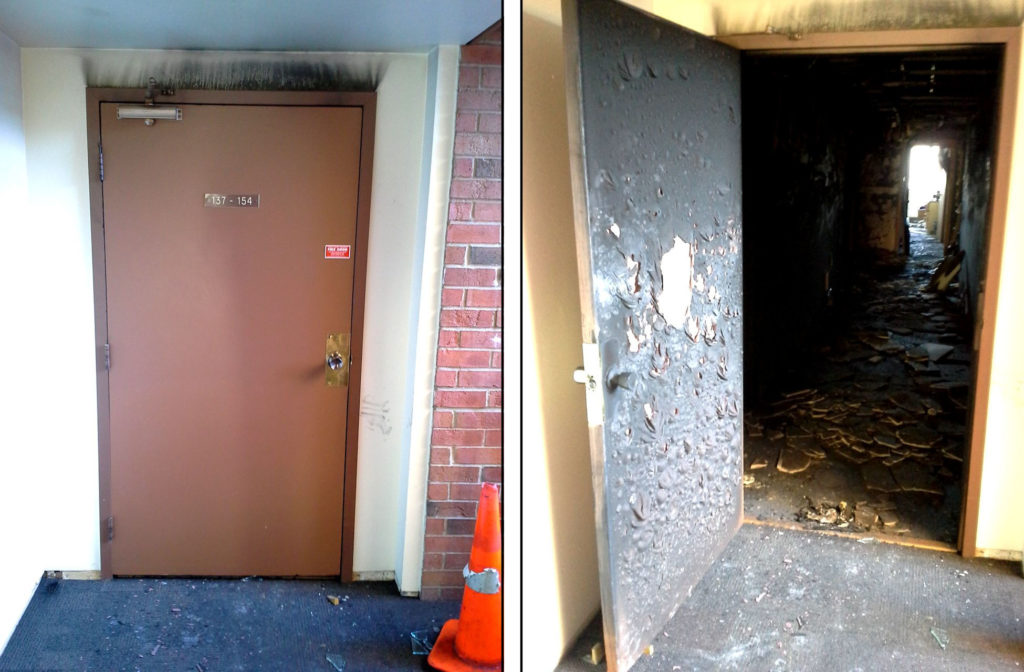
These photos demonstrate the role that code-compliant fire door assemblies play in conjunction with a fire barrier. This closed door prevented the fire from spreading. Photos courtesy of Scott Strassburg, Madison Fire Department
When fire door assemblies are installed correctly, they are expected to deter the spread of smoke and flames for the length of time stated on the fire door label – between 20 minutes and 3 hours of protection. In order to bear a label, the assemblies have been successfully tested by a listing laboratory for that duration. Over time, however, the performance of a fire door assembly can be affected by damage, abuse, and lack of maintenance. If, for example, the door doesn’t close and latch properly, or the wrong type of glazing has been installed in the door or sidelight, the assembly won’t perform as designed and tested.
Imagine a wall with a fire-resistance rating, compartmentalizing a building to help prevent a fire from spreading from one side of the wall to the rest of the building. Now imagine a few door openings in that wall – the doors, frames, and hardware must be fire door assemblies, to maintain the integrity of the fire barrier (wall). If the door closer on one of these doors is disabled or removed, or if the door is propped open with a wood wedge or other mechanical means, the door is likely to be open when a fire occurs. The fire barrier that’s supposed to deter the spread of fire now has a door-sized hole in it which will allow the fire to spread.
That’s what a fire door is for, and that’s why fire door assemblies must be inspected after installation, after maintenance work is performed, and also annually. We can all work to improve the condition of the fire doors we install or repair, and even the fire doors that we pass in our daily lives. If the assembly is not code-compliant, let’s work with building owners to address the deficiencies. Locksmiths with an understanding of current codes can be a key member of the fire-protection team.
For more information about fire door assemblies, visit idighardware.com/firedoor. The NFPA 80 standard can be purchased by visiting nfpa.org.
This article was published in the June 2018 issue of Locksmith Ledger.
You need to login or register to bookmark/favorite this content.

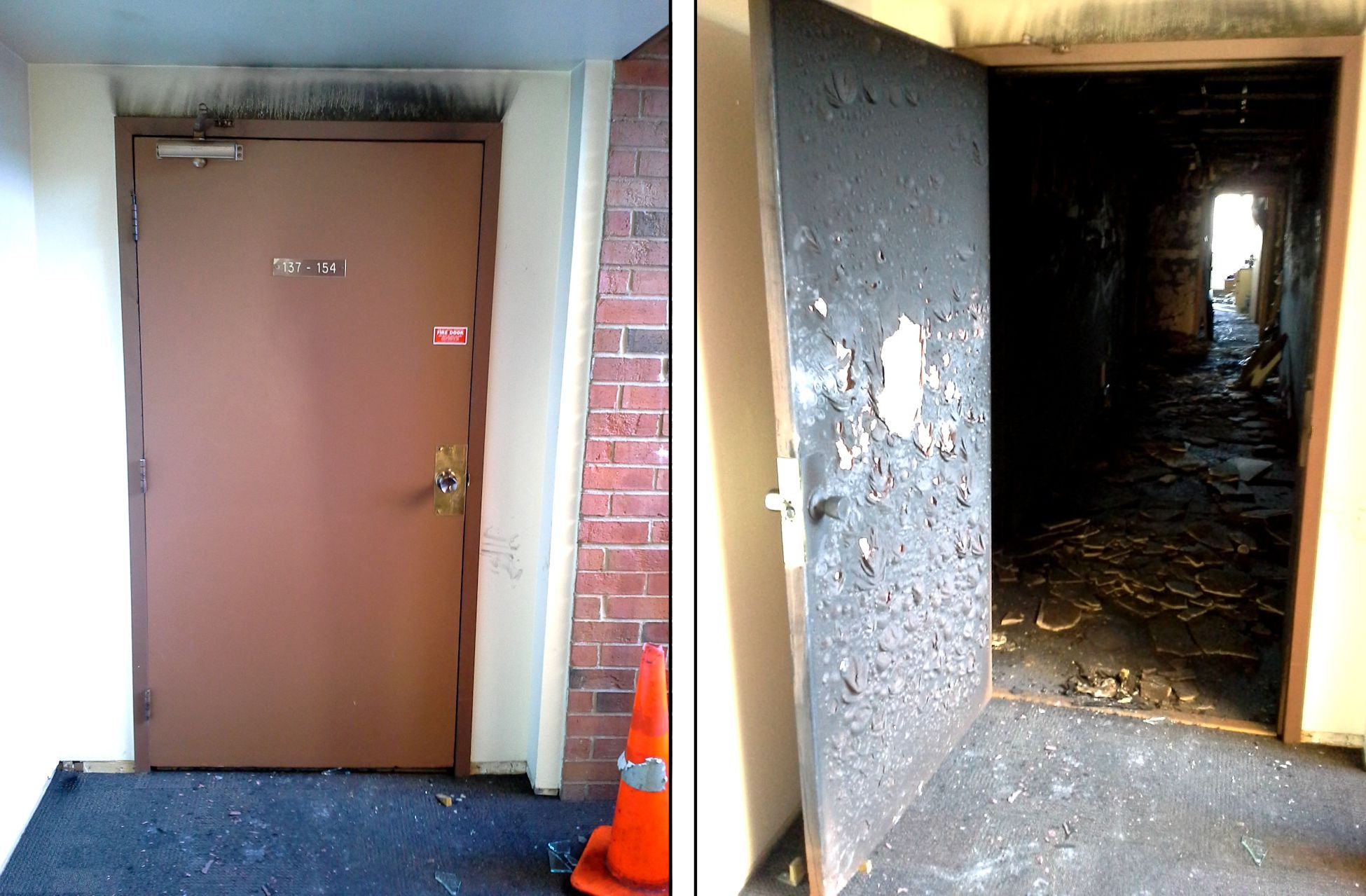
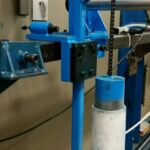
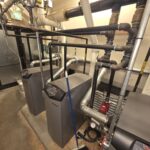

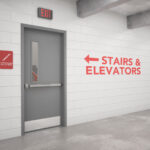
Although I recognize that having doors closed before smoke reaches them is better than having doors which are closed by a thermally-operated mechanism, there are many situations where door closers without hold-opens can be a nuisance, and where closers integrated with a fire alarm system would be cost-prohibitive. I’d thus like to see more encouragement of thermally-operated hold-open devices, since I would expect that adding such devices to fire doors would reduce the frequency with which they are rendered ineffective by people who need to e.g. carry several loads of goods through them.
Would delayed action closers help in some of those situations? NFPA 80 actually allows heat-activated hold-open devices on fire doors – but the IBC and NFPA 101 require doors in certain locations to be smoke-activated (https://idighardware.com/2013/04/decoded-fusible-links-and-smoke-actuated-hold-opens/). If a fire door is not in one of the locations that are required to be smoke-activated, a heat-activated hold-open may be allowed.
– Lori
I just received this issue of LL in today’s mail. Great article!
Great info a must read for all who work and install hardware into and onto Fire Rated assemblies.